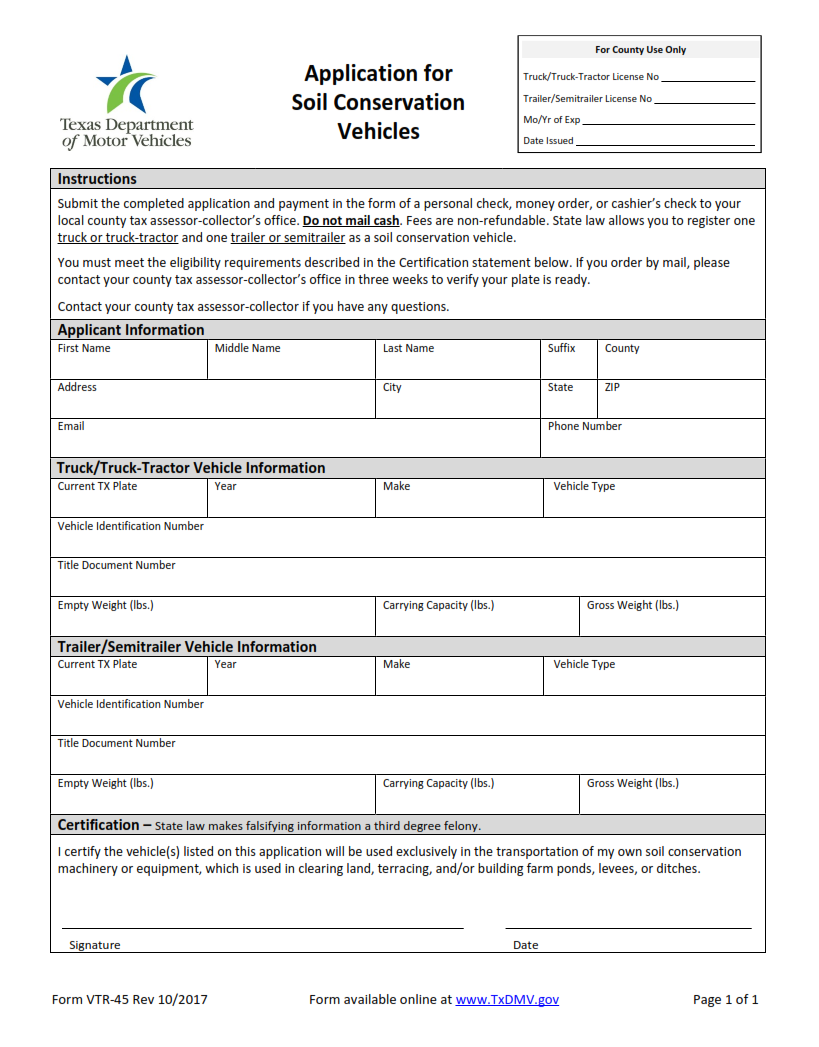ORIGINFORMSTUDIO.COM – VTR-45 – Application for Soil Conservation Vehicles – The VTR-45 is a highly advanced application for soil conservation vehicles. It provides a wide range of automated functions and features that enable users to easily and effectively manage their soil conservation activities. With its advanced capabilities, the VTR-45 has become a popular choice among agricultural professionals looking to maximize the efficiency and effectiveness of their operations. This article will provide an overview of the many advantages the VTR-45 offers to its users, as well as some information about how to properly use this powerful application.
Download VTR-45 – Application for Soil Conservation Vehicles
| Form Number | VTR-45 |
| Form Title | Application for Soil Conservation Vehicles |
| File Size | 1 MB |
| Form By | Texas DMV Form |
What is a VTR-45 Form?
VTR-45, or the Application for Soil Conservation Vehicles, is a form used by vehicle owners in Texas. This form is provided by the Department of Motor Vehicles (DMV) and must be filled out prior to registering any type of soil conservation vehicle. The VTR-45 Form is designed to verify that the proper taxes have been paid on soil conservation vehicles such as tractors, harvesters, and other equipment used in agricultural activities.
The form provides information about all applicable state taxes that must be collected from each buyer before registration can be issued. It also includes sections for recording all relevant information regarding the vehicle being registered, including serial numbers and make/model information. Additionally, this form requires details about the person or company purchasing or leasing the vehicle, along with verification that all applicable federal laws are followed when registering a soil conservation vehicle in Texas.
What is the Purpose of VTR-45 Form?
The VTR-45 form is an application for soil conservation vehicles that must be filled out in order to register a vehicle with the Texas Department of Motor Vehicles. The purpose of the VTR-45 is to provide proof of liability insurance, information about the owner and operator of the vehicle, and other important details about the vehicle itself.
The VTR-45 form requires applicants to provide details such as make and model, fuel type, Gross Vehicle Weight Rating (GVWR), registration number, and Vehicle Identification Number (VIN). Additionally, applicants must also provide their name, address, telephone number(s), email address(es) and driver’s license information.
Where Can I Find a VTR-45 Form?
The VTR-45 form is the state of Texas’ official application for soil conservation vehicles. It can be found on the Texas Department of Motor Vehicles (TxDMV) website. The form must be filled out in its entirety and submitted with all applicable supporting documents to either a TxDMV regional service center or county tax office.
Once the VTR-45 form has been completed, it must be filed with the local registration authority along with other required documents, such as proof of ownership or lease agreement and proof of financial responsibility. The registration authority may also require additional documents in order to process the application. Before submitting a completed VTR-45 form, applicants should make sure that they have included all necessary information and documentation to avoid processing delays.
VTR-45 – Application for Soil Conservation Vehicles
The VTR-45 is an application for soil conservation vehicles that provides farmers with an easy-to-use tool to monitor and manage their soil health. The application offers comprehensive data about the soil’s physical, chemical and biological properties, giving farmers a deeper understanding of the status of their land. Furthermore, it allows them to access local weather information and make smart decisions about how to best manage their fields.
Using the VTR-45 application, farmers can adjust fertilizers, irrigation levels, planting strategies and other practices that affect soil health. It also helps them identify areas of concern in order to address any nutrient deficiencies or compaction issues before they become too severe. This can lead to better crop yields and improved overall land management.
VTR-45 Form Example
